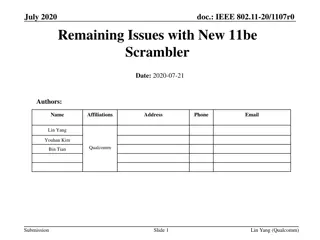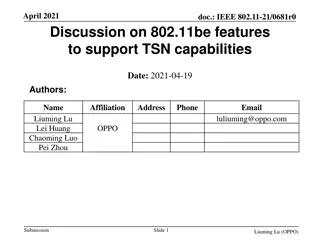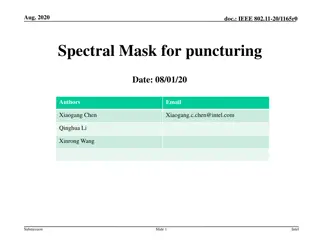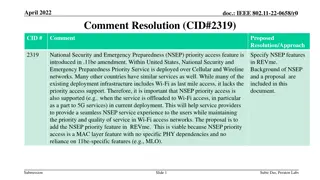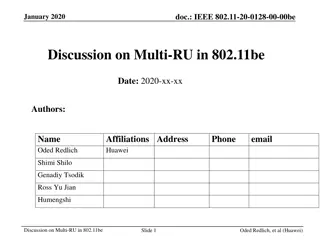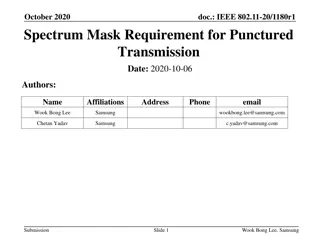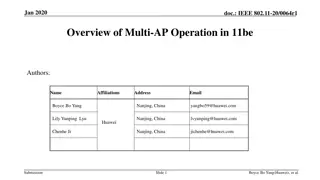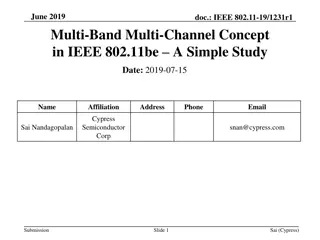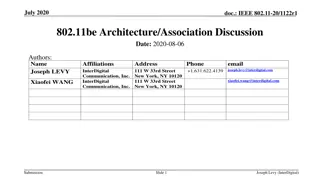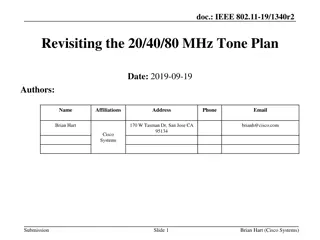Issues with SCS Operation in IEEE 802.11be Standard
The document discusses technical issues related to the SCS (Spatial Channel Sharing) operation in the IEEE 802.11be standard. It highlights inconsistencies in the standard regarding parameterized QoS requirements, mixing of traffic streams with different QoS needs, and challenges in prioritizing SCS streams. Suggestions for addressing these issues and improving QoS measurement are also presented.
Download Presentation

Please find below an Image/Link to download the presentation.
The content on the website is provided AS IS for your information and personal use only. It may not be sold, licensed, or shared on other websites without obtaining consent from the author. Download presentation by click this link. If you encounter any issues during the download, it is possible that the publisher has removed the file from their server.
E N D
Presentation Transcript
January 2022 doc.: IEEE 802.11-20/2037r0 Some Issues on SCS Operation Date: 2022-1-10 Authors: Name Guogang Huang Affiliations Huawei Address Phone email huangguogang1@huawei.com Ming Gan Yuchen Guo Yunbo Li Yiqing Li Mengyao Ma Michael Montemurro Stephen McCann Submission Slide 1 Guogang Huang, et al
January 2022 doc.: IEEE 802.11-20/2037r0 Background In pre-11be, the SCS operation is used to map a SCS stream without parameterized QoS requirements (i.e. no QoS Characteristics element is included within the SCS Descriptor element) into a transmit category (TID/UP 0-7). In 11be, the SCS operation is modified to report a SCS stream with parameterized QoS requirements. In this contribution, we discuss technical issues for the SCS operation based on the current draft text. Submission Slide 2 Guogang Huang, et al
January 2022 doc.: IEEE 802.11-20/2037r0 Motivation There is some inconsistency in 802.11be D1.1 : - In 802.11, the MPDU delivery is per TID, e.g. SN assignment, BA agreement and TID-based measurement Request/Report (i.e. transmit stream/category measurement Request/Report) - But for the SCS operation, each SCS stream is identified by the SCSID. According to the current draft text, the TID values from 0 to 7 are used in 11be. Then the following situation will very probably happen: - Issue 1. The traffic belonging to SCS streams with parameterized QoS requirements will mixed with the traffic without parameterized QoS requirements (i.e. based on DSCP-to-UP mapping ) - Issue 2. The traffic belonging to a SCS stream will mixed with the traffic belonging to another SCS stream with different QoS requirements - Submission Slide 3 Guogang Huang, et al
January 2022 doc.: IEEE 802.11-20/2037r0 Existing Issues For example, - SCS Request/Response with SCSID #i, Request Type=ADD, TID #n, Direction=UL, QoS_Requirement1 - SCS Request/Response with SCSID #j, Request Type=ADD, TID #n, Direction=UL, QoS_Requirement2 Then the question is how to derive the QoS requirement for TID #n? - It s hard to fuse different QoS requirements of SCS streams, e.g. Delay Bound, MSDU Delivery Ratio and so on. - Even it can be achieved, the SCS stream with relatively low QoS requirements will take advantage of medium access offered to SCS stream with relatively high QoS requirements - Furthermore, in this case, the transmitter cannot prioritize the traffic belonging to a particular SCS stream since the traffic belonging to different SCS streams but sharing the same TID are mixed together. And we need to define a new SCSID-based measurement report to provide the statistic info on the experienced QoS, which is very useful to AP to see if there is improvement in QoS. Submission Slide 4 Guogang Huang, et al
January 2022 doc.: IEEE 802.11-20/2037r0 Related CIDs Clause Number CID Commenter Comment Proposed Change The MAC needs to be able to measure the delay of data delivery, from the time when data is passed from the upper layer till successful delivery at the peer MAC. This is fundamental to see if there is improvement in delay. 7620 Tomoko As in comment. 5196 Guogang Huang 35.6 need to define a QoS report for the low- latency traffic stream, maybe we can reuse the existing measurement report, e.g. Transmit Stream/Category Measurement Request/Report As in comment Submission Slide 5 Guogang Huang, et al
January 2022 doc.: IEEE 802.11-20/2037r0 Proposal 1 In order to separate the traffic belonging to SCS streams from the traffic without parameterized QoS requirements (i.e. based on the QoS mapping), the SCS stream is classified into two types SCS stream without parameterized QoS Requirements i.e. there is no QoS Characteristics element within the SCS Descriptor element SCS stream with parameterized QoS Requirements i.e. there is a QoS Characteristics element within the SCS Descriptor element For the SCS stream without parameterized QoS Requirements, It still follow the pre-11be SCS operation, i.e. allowing more than one SCS stream to be mapped to the same TID (0-7) For the SCS stream with parameterized QoS Requirements, The TID values from 8 to 15 (i.e. TSID) are used Submission Slide 6 Pascal Viger, Canon, et al
January 2022 doc.: IEEE 802.11-20/2037r0 Proposed Draft Text The TID subfield of the Control Info field of the QoS Characteristics element are modified as follows: - Rename the TID subfield as the TSID subfield and define as follows: The TSID subfield contains a value (8-15) that is a TSID. Note that the MSB (bit 4 in TS Info field) of the TSID subfield is always set to 1 when the QoS Characteristics element is included within a SCS Response frame. Submission Slide 7 Guogang Huang, et al
January 2022 doc.: IEEE 802.11-20/2037r0 Proposal 2 In order to separate the traffic belonging to a SCS stream with parameterized QoS requirements from the traffic belonging to other SCS streams with parameterized QoS requirements, each SCS stream with parameterized QoS requirements is assigned a dedicated TSID. SCSID (i.e. SCS stream) TSID + Direction (i.e. TS) Then we can use the TID to differentiate the latency sensitive traffic. - Currently, Section 35.7.2.1 Latency sensitive traffic differentiation of 802.11be D1.1 is empty Submission Slide 8 Guogang Huang, et al
January 2022 doc.: IEEE 802.11-20/2037r0 Proposed Draft Text The SCS stream with parameterized QoS requirements (i.e. TS) is also identified by the TSID (8-15) and Direction fields within the QoS Characteristics element besides the SCSID. A non-AP EHT STA may attempt to modify the parameters of a QoS Characteristics element for a particular SCS stream by transmitting a SCS Request frame with the Request Type equal to Change, the corresponding SCSID, TSID and Direction. If the Status Code in the corresponding SCS Response frame is SUCCESS, then the QoS Characteristics element with the same TSID and Direction is overridden with the QoS Characteristics element in that frame. The AP can reject the non-AP STA s SCS request due to the incorrect TID/UP used. Submission Slide 9 Guogang Huang, et al
January 2022 doc.: IEEE 802.11-20/2037r0 Summary This contribution discussed about the current issue on the SCS operation and classify the SCS stream into two types: SCS stream without parameterized QoS Requirements SCS stream with parameterized QoS Requirements For the SCS stream without parameterized QoS Requirements, It still follow the pre-11be SCS operation, i.e. allowing more than one SCS stream to be mapped to the same TID (0-7) For the SCS stream with parameterized QoS Requirements, The TID values from 8 to 15 (i.e. TSID) are used Each SCS stream with parameterized QoS requirements is assigned a dedicated TSID. Submission Slide 10 Pascal Viger, Canon, et al
January 2022 doc.: IEEE 802.11-20/2037r0 Straw Poll #1 Do you support to extend TID from 0-7 to 0-15 in 11be? Results: Y/N/A Submission Slide 11 Pascal Viger, Canon, et al
January 2022 doc.: IEEE 802.11-20/2037r0 Straw Poll #2 Do you support that the TID value within 8 to 15 (i.e. TSID) is used to identify a SCS stream with parameterized QoS requirements? Results: Y/N/A Submission Slide 12 Guogang Huang, et al
January 2022 doc.: IEEE 802.11-20/2037r0 Backups Submission Slide 13 Guogang Huang, et al
January 2022 Comparison between ADDTS and SCS doc.: IEEE 802.11-20/2037r0 Features ADDTS SCS Differentiation TSID SCSID The TS is identified by the TSID (8-15) and Direction fields within the TSPEC element (REV1.0 P1852L57) The SCSID field is set to a nonzero value chosen by the non-AP STA identifying the SCS stream specified in this SCS Descriptor element. QoS Parameters TSPEC element QoS Characteristics element The TSPEC element contains the QoS parameters that define the TS The QoS Characteristics element contains a set of parameters that define the characteristics and QoS expectations of a traffic flow Baseline Each TS is mapped to a dedicated TSID. When the STA reports a new TS with a TSID which has already been used before, the new request will override the previous one. (One TS -to-one TSID, see Appendix) Maybe several application-level SCS streams are mapped to the same TID (Many SCSID-to-one TID) Measurement Report TID-based Measurement Report It will cause the TID-based measurement report useless. Maybe a SCSID-based measurement report is needed. The AP can directly take some actions to improve the experienced QoS for a specific TS. Because the current transmission architecture is based on TID The AP cannot directly take some actions to improve the experienced QoS for a specific SCS stream. Because the current transmission architecture is based on TID Fairness issue There is no fairness issue because A dedicated TSID is assigned to each TS The AP can reject the non-AP STA s request due to the incorrect UP used. Fairness issue 1. The SCS streams sharing the same TID will take advantage of the SCS stream with the highest QoS requirements Fairness issue 2. Different STAs may select different TID/UP/AC for the similar SCS stream. Hence, it shall be the AP to decide which UP/TID is used. Submission Slide 14 Guogang Huang, et al
January 2022 doc.: IEEE 802.11-20/2037r0 TS Operation Submission Slide 15 Guogang Huang, et al











